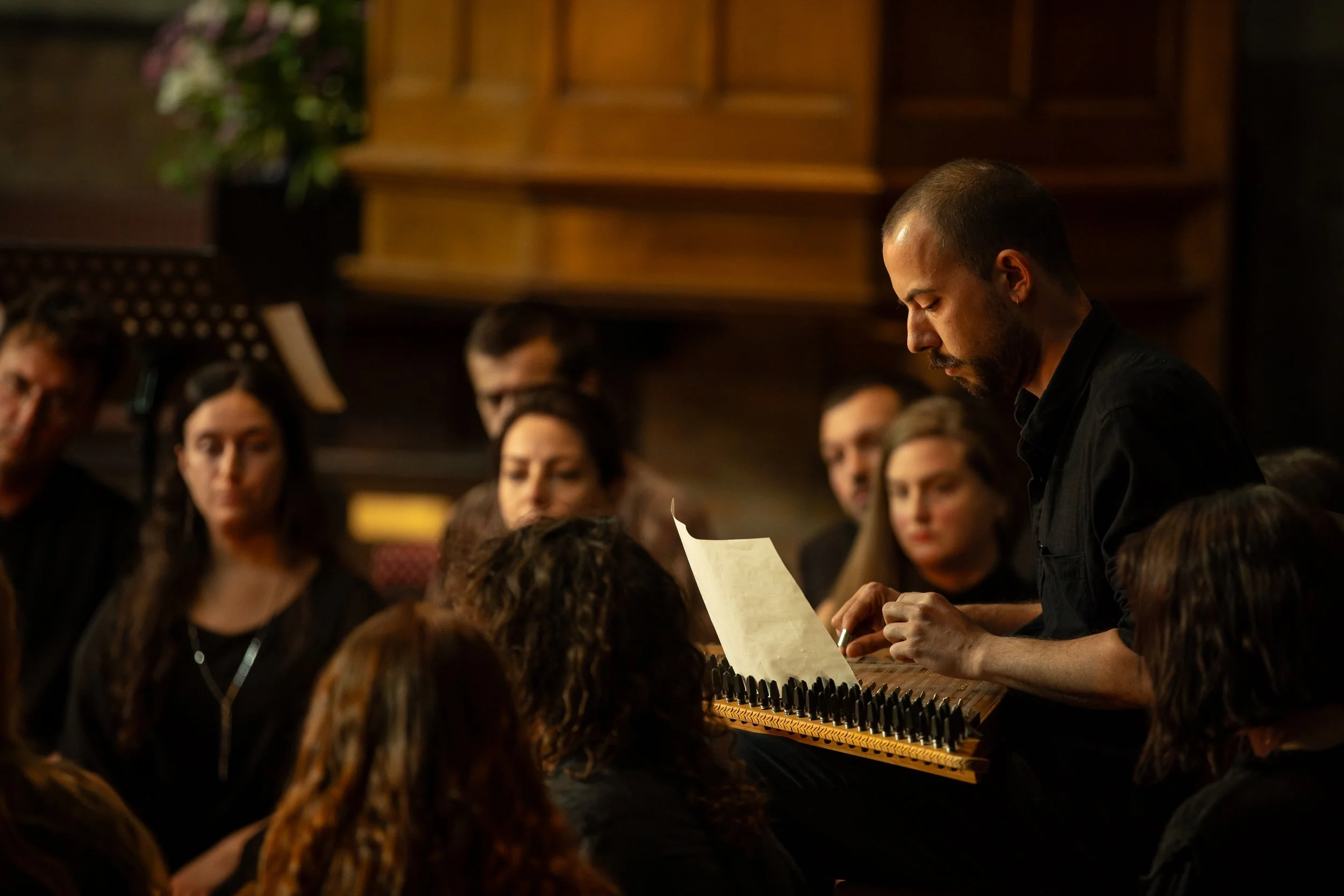Singer & Scribe
Welcome to our blog - a space where members of Idrîsî share thoughts, discoveries, and dreams connected to our work.
Our first London concert, Singer & Scribe, was an important stepping stone for us. Here are the programme notes from that night - a brief introduction to our music and ethos. People often ask me for recommended books and articles, so I’ve also included a non-exhaustive list of sources and further reading for those who’d like to delve deeper.
John Dagenais posited that the colonisation of the past is an indispensable companion of empire, characterising the Middle Ages as a vastness of time ripe for exploitation. Nations are indeed narrations, stories are at the heart of our struggles for power and territory. The articulation of modernity hinges on the appropriation and negotiation of medieval and non-European histories: in the context of classical music, nowhere is this more apparent than in the field of plainchant.
Old Roman chant is virtually absent from the UK scene: until recently, the only performance practice specialist was based in France. However, it provides a miraculous insight into late antiquity traditions, and constitutes an invaluable resource on medieval ornamentation practices, one strikingly consistent with period treatises. Only rediscovered in the 20th century, Old Roman chant was first neglected and pronounced a decadent, distorted chant. Concurrently, prominent liturgists such as Théodore Nisard described microtones as ‘monstrosities’ akin to ‘the meowing that we call Arabic Music’. Even today, very few cantors take the risk of interpreting Old Roman chant, as it challenges enduring myths of foundational purity, and theories that have prevailed for a century about the interpretation of Gregorian chant and medieval music. One hundred and thirty years after its discovery, Old Roman chant has yet to claim the central place it deserves in our collective imagination. These manuscripts reveal the syncretic nature of our cultures and religions, transporting us back to the ancient Mediterranean – a realm of porous borders, fluid identities and ceaseless contradictions. The vocal techniques required for its performance, along with the aesthetics captured in these manuscripts, must be reclaimed as integral components of our own histories.
Musicological research overwhelmingly points to the necessity of incorporating intangible heritage into our performances of medieval repertoire. Nurturing such a dialogue between singer and scribe is not only necessary to make sense of this extraordinary music, but may also help us uncover alternative legitimacies, timelines, histories, and structures of knowledge production that do not exist yet in our institutions. I am convinced that meaningful psychological change can occur if we adapt our understanding, teaching, and performance of these key building blocks of our identities. The ancient Mediterranean, intrinsically woven into the narrative of modernity, always already complicates postcolonial discourses of alterity and conflict. By returning European history to the sea – alongside plainchant and troubadour song – we may observe and renegotiate their contours and constitution.
Thomas Fournil
Konstantinos Glynos performing in Singer & Scribe. Photograph by Genevieve Reeves.
Sources and further reading
Bergeron, Katherine. Decadent Enchantments: The Revival of Gregorian Chant at Solesmes. University of California Press, 1998.
Bushnell, Cameron F. A. E. Postcolonial Readings of Music in World Literature. ROUTLEDGE, 2017.
Chakrabarty, Dipesh. Provincializing Europe: Postcolonial Thought and Historical Difference. Princeton, N.J: Princeton University Press, 2012.
Chambers, Iain. Mediterranean Crossings: The Politics of an Interrupted Modernity. Durham, N.C: Duke University Press, 2008.
Dagenais, John. “Decolonizing the Middle Ages: Introduction.” Journal of Medieval and Early Modern Studies.
Ewell, Philip. “Music Theory’s White Racial Frame.” Music Theory Spectrum, vol. 43, no. 2, 2020.
Froger, Dom J. Les prétendus quarts de ton dans le chant grégorien et les symboles du ms. H.159 de Montpellier. Études Grégoriennes 19. Abbaye Saint-Pierre de Solesmes, 1978.
Hornby, Emma. Gregorian and Old Roman Eighth-Mode Tracts: A Case Study in the Transmission of Western Chant. Milton: Routledge, 2018.
Huglo, Michel, Marcel Pérés, and Christian Meyer. Polyphonies de Tradition Orale: Histoire et Traditions Vivantes : Actes du Colloque de Royaumont 1990. Paris: Créaphis, 1993.
Jeffery, Peter. Re-Envisioning Past Musical Cultures: Ethnomusicology in the Study of Gregorian Chant. University of Chicago Press, 1992.
Kinoshita, Sharon. Medieval Boundaries: Rethinking Difference in Old French Literature, 2013.
Leech-Wilkinson, Daniel. The Modern Invention of Medieval Music: Scholarship, Ideology, Performance. Cambridge: Cambridge University Press, 2007.
Lousberg, Leo A. G. Microtones According to Augustine: Neumes, Semiotics and Rhetoric in Romano-Frankish Liturgical Chant. Utrecht University, 2018.
McGee, Timothy J. The Sound of Medieval Song: Ornamentation and Vocal Style According to the Treatises. Oxford: Clarendon Press, 1998.
Mocquereau, André. Paléographie Musicale, II. Tournay (Belgique: Société de Saint-Jean L’Évangéliste/Desclée, 1924.
Moore, Megan. Exchanges in Exoticism: Cross-cultural Marriage and the Making of the Mediterranean in Old French Romance. University of Toronto Press, 2014.
Nisard, Théodore. L'Archéologie Musicale et le Vrai Chant Grégorien. Lethielleux, 1890.
Olwage, Grant. “The Class and Colour of Tone: an Essay on the Social History of Vocal Timbre.” Ethnomusicology Forum, vol. 13, no. 2, 2004.
Pérès, Marcel, and Jacques Cheyronnaud. Les Voix du Plain-Chant. Paris: Desclée de Brouwer, 2001.
Pothier, Joseph, and Jacques Chailley. Les Mélodies Grégoriennes. Paris: Stock, 1980.
Raillard, F. Emploi des Quarts de Ton dans le Chant de l’Église. Paris: Impr. de Lahure, 1858.
Ricossa, Luca. Hyeronimus de Moravia: Ornamentation and Exegesis in Gregorian, Old Roman, and Byzantine Chant. Lecture, International Congress on Medieval Studies, Kalamazoo, MI, 7 May 2006.
Said, Edward W. Culture and Imperialism. Vintage, 1994.
Sherman, Bernard D. Inside Early Music: Conversations with Performers. New York: Oxford University Press, 1997.
Vincent, Alexandre-Joseph-Hyacinthus. Emploi des Quarts de Ton dans le Chant Grégorien: Constaté sur l’Antiphonaire de Montpellier. Paris: Leleux, 1854.

